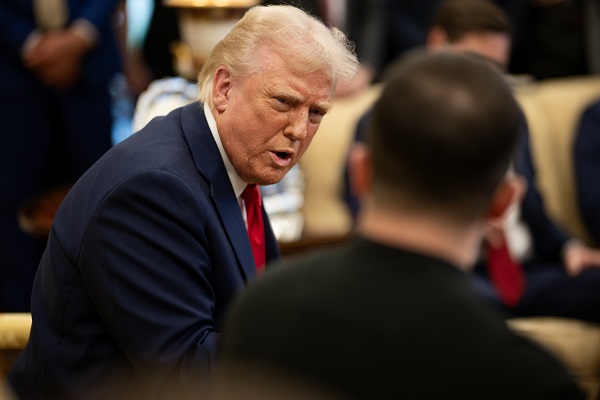.png)
March 4, 2025 at 1:47 AM IST
US President Donald Trump announced 25% tariffs on goods from Mexico and Canada will take effect from Tuesday, reigniting fears of a North American trade war and sending financial markets into turmoil. Trump said there was “no room left” for a deal to avoid the tariffs, which he linked to efforts to curb fentanyl flows into the US. He also reaffirmed plans to raise tariffs on all Chinese imports to 20% from 10%, citing Beijing’s failure to halt fentanyl shipments. The new tariffs, covering over $900 billion in annual US imports, are expected to deal a significant blow to the tightly integrated North American economy, rattling companies with cross-border supply chains.
Data
The Institute of Supply Management’s US manufacturing PMI slipped to 50.3 in February from 50.9 in January, hovering just above the 50-mark that indicates sector growth, as factories likely front-loaded imports to avoid tariffs. While US manufacturing remained steady, a measure of factory gate prices surged to a near three-year high, and delivery times for materials lengthened, signalling potential production challenges ahead.
Manufacturers in the ISM survey expressed widespread concerns about tariffs, with many citing President Donald Trump’s duties on imports from Canada, Mexico, and China as a major source of uncertainty. These trade policies, they warned, could soon disrupt operations and undermine the sector’s fragile recovery, adding to broader economic risks.
Markets
Overnight
US stocks indices tumbled on Monday after President Donald Trump announced 25% tariffs on Canada and Mexico, effective Tuesday, with reciprocal tariffs starting April 2. The S&P 500 posted its largest daily decline since December 18, led by drops in energy and technology sectors, with Nvidia falling 8.7% and Amazon down 3.4%. Defensive sectors like real estate, healthcare, and utilities gained as investors sought safety, but the selloff highlighted growing fears over the economic fallout from escalating trade tensions and geopolitical risks.
US Treasury yields declined on Monday, with longer-dated bonds leading the drop following a disappointing manufacturing sector report. The yield on the benchmark 10-year note fell 7 basis points to 4.159%, as investors shifted focus to Friday’s January payrolls report for further insights into the labour market and economic momentum. Softer economic data in recent weeks has increased expectations that the Federal Reserve may adopt a more aggressive stance on rate cuts this year.
The US dollar fell on Monday, with the dollar index dropping 0.72% to 106.54, as hopes for a Ukraine peace deal boosted the euro and interest rate differentials shifted against the greenback ahead of key US payrolls data later in the week. Meanwhile, European leaders agreed over the weekend to draft a peace plan to present to the US, following Ukrainian President Volodymyr Zelenskiy’s contentious meeting with Trump. The dollar’s decline reflected a mix of geopolitical optimism and concerns over escalating trade tensions, leaving markets volatile as investors balanced conflicting economic and political signals.
Brent crude oil prices dropped about 2% to a 12-week low on Monday, pressured by reports that OPEC+ plans to proceed with an oil output increase in April and concerns that US tariffs could dampen global growth. The combination of rising supply and fears of weaker demand weighed heavily on markets, with Brent crude and WTI both extending losses. The decline reflects growing unease over the balance between supply dynamics and the potential economic fallout from escalating trade tensions.
Day’s Ledger
Economy
- US February ISM report on business manufacturing PMI
- US February domestic auto industry sales data
- Eurozone January unemployment rate
- US Johnson Redbook retail sales index for the week ended March 1
Companies
- Coforge Ltd’s board to consider stock split
Policy
- Mizoram government to present Budget for FY26.
- US Federal Reserve Bank of Richmond President Thomas Barkin speaks
Tickers
- CEAT has received the Certificate of Incorporation for its subsidiary in Sri Lanka, namely CEAT OHT Lanka (Private) Ltd
- GODREJ PROPERTIES cancelled the agreement with TCM for the development of a land parcel in Thrikkakara, Kochi.
- INDIAN ENERGY EXCHANGE electricity traded volume in February increased by 9% YoY to 9,622 million units (MU).
- INTELLECT DESIGN ARENA's Canada arm completes transfer of Central 1 digital banking operations
- RBL BANK informed that GST authorities have initiated search at 3 offices of the bank in Maharashtra. Proceedings are on-going & the bank is co-operating fully in providing data as per request placed.
- REC Board will meet on March 7 to consider the proposal for a revision in the market borrowing program of the company for the financial year 2024-25.
- SUNTECK REALTY has incorporated its wholly owned subsidiary, Eximius Buildcon (EBPL).
- WENDT INDIA has approved a proposal for incorporating a wholly owned subsidiary in Germany to further its business prospects in Europe.
- XCHANGING SOLUTIONS has appointed Swaminathan as Managing Director and Chief Executive Officer of the company for 3 years, effective March 4.
Must Read
- India's Power grid facing warnings due to sudden dip in solar power generation
- India's Ola Electric to cut jobs; over 1,000 roles impacted
- SEBI permits all NBFCs, HFCs to invest in security receipts by ARCs
- Study abroad turns into stash cash abroad; RBI takes note
- Tata Capital eyes $11 billion valuation for India IPO
- Centre plans to auction 30 underground coal mines in the next round
- OPEC+ to Begin Long-Delayed Supply Hike Amid Trump Pressure
- US pauses military aid to Ukraine, media report
- Adani Green refinances $1 billion loan for hybrid project in Rajasthan
- Jio, Nokia, AMD & Cisco launch AI platform
Daily Mantra
Waves are inspiring not because they rise and fall, but because they never fail to rise again. Always see yourself as humble, it’s the easiest path to achieving greatness.
Musings

The Trump administration’s halt on military aid to Ukraine and potential easing of sanctions on Russia signals a major shift in US foreign policy.
Following a tense meeting between Trump and Zelensky, this move suggests a pivot away from Ukraine in favor of improving US-Russia relations. This dramatic change could reshape global geopolitics and questions the US’s commitment to NATO and European security. The immediate impact on global markets is likely to be significant. Investor sentiment could be shaken by rising geopolitical risks, particularly in Eastern Europe. Energy markets, especially oil, may face volatility if sanctions on Russia are eased, disrupting global supply chains and commodity prices. For Europe, the absence of US support in NATO poses a new challenge. With an emergency NATO meeting held without the US, European leaders may need to rethink their security strategies, increasing market uncertainty. A weakened NATO could lead to volatility in European markets and broader global instability. This shift points to a more fragmented world order. As the US redefines its global role, Europe may have to step up its security efforts, further disrupting global markets and increasing uncertainty in the international economic landscape. - Chetan Chandak
Chetan is a published author and a dabbler in mysticism. By day, he trades currency derivatives at an Indian private bank; after hours, he delves into ideas beyond the numbers. His musings—part reflection, part curiosity—are his own and don’t represent views of his bank.




